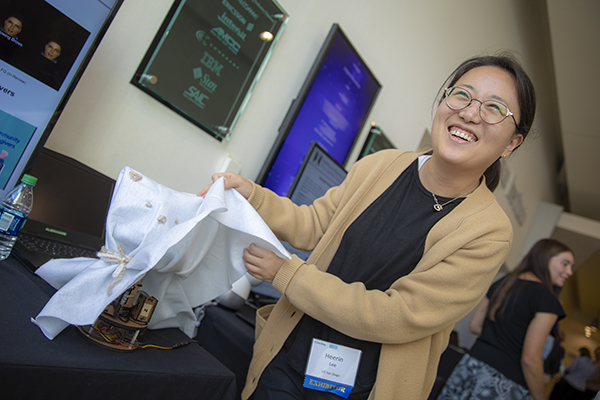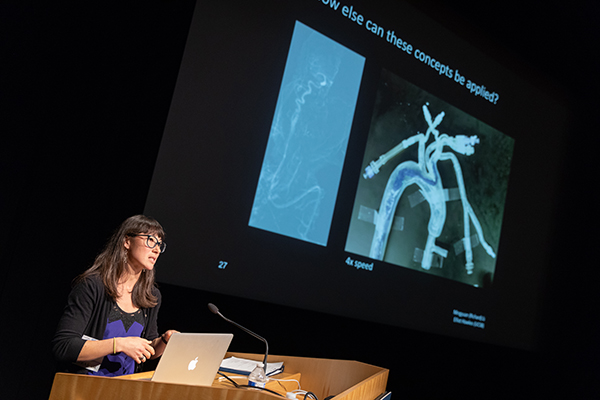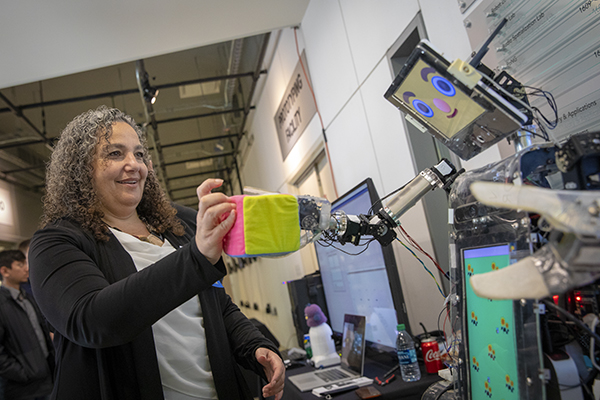From Caregivers to Hospital and Surgery Assistants: The Future of Healthcare Robotics
Published Date
By:
- Ioana Patringenaru
Share This:
Article Content
Researchers discuss the role of robots in healthcare at UC San Diego event
By 2050, the number of people over age 60 will double worldwide. By 2100, it will triple. This population shift will generate dramatically increased demand for caregiving and healthcare services--demand that can’t be met by humans only. In addition, five billion people worldwide lack access to adequate healthcare, especially surgery.
These are some of the problems that experts in the field of healthcare robotics from industry and academia came together to tackle during the 2018 Contextual Robotics Institute Forum held Nov. 8 at the University of California San Diego.
Robots could help solve the former by becoming caregivers and helpers in the home and hospital, researchers said. Robotics can also develop better tools for all clinicians to help reduce burnout, and broaden access to healthcare.
“Robotics researchers are ready to make a big impact,” said UC San Diego Chancellor Pradeep K. Khosla. UC San Diego is playing an important role in bringing together clinicians and engineers to help solve the looming challenges in healthcare and home care, he added.
The need for additional research was underlined during an industry panel that included two companies making robotic home companions— Diligent Robotics and Catalia Health— as well as robotic surgery manufacturer Intuitive and semiconductor startup Atlazo.
The Contextual Robotics Institute at UC San Diego is poised to play a central part in building bridges between the Jacobs School of Engineering, the Division of Social Science and the School of Medicine to conduct this research, said Henrik Christensen, the institute’s director and a professor in the Department of Computer Science and Engineering.
“Using robotics in healthcare across clinical and domestic applications will offer tremendous opportunities to improve everyone’s quality of life,” Christensen said. “As the focus of the Contextual Robotics Institute is on empowering people to use robotics technology, this is extremely important for us. We see tremendous opportunities to work with a diverse set of companies in this domain as San Diego and Southern California has a significant number of opportunities in this space.”
Robots as caregivers in the hospital and in the home

Postdoctoral researcher Hee Rin Lee, from the research group of computer science professor Laurel Riek, shows off one of the lab's robots.
For example, Laurel Riek, a UC San Diego professor of computer science, is working with emergency room clinicians to develop robots that can detect and recognize clinician activities and deliver supplies on the fly, which will reduce workload and improve patient safety. This requires solving a number of problems.
“We want robots to enter an environment, sense people within it, and immediately know what they need to do,” Riek said. “It’s important that robots do the right thing, at the right time, and in the right way, especially in safety critical environments.”
Her research team has developed a number of methods to make this easier, focused on human-robot teaming, machine learning, and computer vision. “These methods are fast, don’t require large training sets, and are robust,” Riek said.
In collaboration with community health workers, Riek also focuses on creating personalized robots that meet the needs of individuals. For example, she is designing new robots with family caregivers and people with dementia to imagine future technology that can support them in their daily lives, as well as tailor and personalize how they provide support.
During the forum, other researchers described similar efforts. Cynthia Breazeal from MIT is asking how machines powered by artificial intelligence can help people flourish. Her team created a teddy-bear like interactive robot for children at Boston Children’s Hospital. The robot helped the kids interact more with their caregivers.
Michelle Johnson, from the University of Pennsylvania, is helping develop affordable, mobile robot therapists working in rehabilitation centers and senior facilities. Lena Ting, from Georgia Tech and Emory University, studies how humans interact with one another to improve how robots interact with humans. Bernadine Dias, from consulting firm Diyunu, helped develop assistive travel robots.
Meanwhile, Virginia de Sa, a professor in the UC San Diego Department of Cognitive Science, explained how her research group is refining and improving computer vision algorithms to detect and rate levels of pain. This would allow for automatically classifying pain levels in a hospital setting.
The work is based on work started at UC San Diego and the University of Toronto, which showed that computer systems are better at spotting real or faked expressions of pain than humans. Researchers later spun the technology into Emotient, a startup providing market analytics based on facial expression data. The company was acquired by Apple in 2016.
De Sa also described research on using EEG to assess memory in older adults. Robots can be built to emulate human senses, De Sa said, and they also can be built to do “extra-sensory” work.
Robotic tools for surgery

Tania Morimoto, an assistant professor in the Department of Mechanical and Aerospace Engineering, presented on flexible, robotic surgical tools during the 2018 Contextual Robotics Institute Forum.
In addition to the role of caregivers, robots can also assist physicians, especially in the operation room. UC San Diego already is a leader in the field of robotic surgery, said Dr. Santiago Horgan, director of the Center for the Future of Surgery at UC San Diego. But there is still plenty of room for improvement.
Improving robotic surgery and bringing costs down is important because more than 5 billion people worldwide don’t have access to quality surgical care and more than 5 million of them die because of this, said Greg Hager, a professor at Johns Hopkins University.
From intelligent algorithms that can enable robots to lend a helping hand during surgery, to “smart” endoscopes that can autonomously maneuver through sensitive nooks and crannies inside the body, Michael Yip, a professor in the UC San Diego Department of Electrical and Computer Engineering, develops technologies to augment the capabilities of surgeons.
Bringing autonomy to surgery procedures is similar to developing self-driving cars, Yip said. The process involves different levels of autonomy, from surgeons controlling devices all the way to full autonomy, which is not available yet. “We are not trying to take the surgeon out of the procedure,” Yip said. “We are trying to improve existing procedures and make new ones available.”
Yip is currently working on augmented reality systems that predict where instruments should go before they are moved, to visual-haptic feedback that predicts and displays how much force remotely controlled instruments are applying to tissues. To get closer to full autonomy, Yip also is working on self-steering flexible instruments for vascular navigation, as well as safety-aware robots that assist surgeons in clearing fluids in the environment and other secondary tasks.
Flexible robotics is also an area of expertise for Tania Morimoto, a professor in the UC San Diego Department of Mechanical and Aerospace Engineering. “Existing systems tend to be extremely large and expensive,” she said during the forum. “And they are hard to customize.”
Customization is important to be able to serve specific patient groups, such as children. Morimoto uses pre-op scans to build 3D models of the operation site. A surgeon then designs a patient-specific set of flexible robotic instruments, using the virtual-reality interface she developed. These flexible tools are 3D-printed and controlled by the surgeon via a haptic interface. To-date the development of these customized tools has been focused on enabling safer access to the pediatric kidney.

Andrea Chiba, a professor in the Department of Cognitive Science, and RUBI the robot, who is designed to interact with children.
Earlier in the day, Morimoto listened to her Ph.D. mentor, Allison Okamura, a professor at Stanford, explain the importance of touch for robots. “We have to consider the social and emotional aspects of touch,” Okamura said. “This is difficult for our field.”
Ultimately, whether it’s in the home, the hospital, or the community, robots and humans will have to learn how to live and work together, the researchers said.
“Healthcare robotics is ultimately about supporting public health,” said UC San Diego computer science professor Riek. “Success requires that we invest to preserve health through every stage of life.”
Share This:
Stay in the Know
Keep up with all the latest from UC San Diego. Subscribe to the newsletter today.



